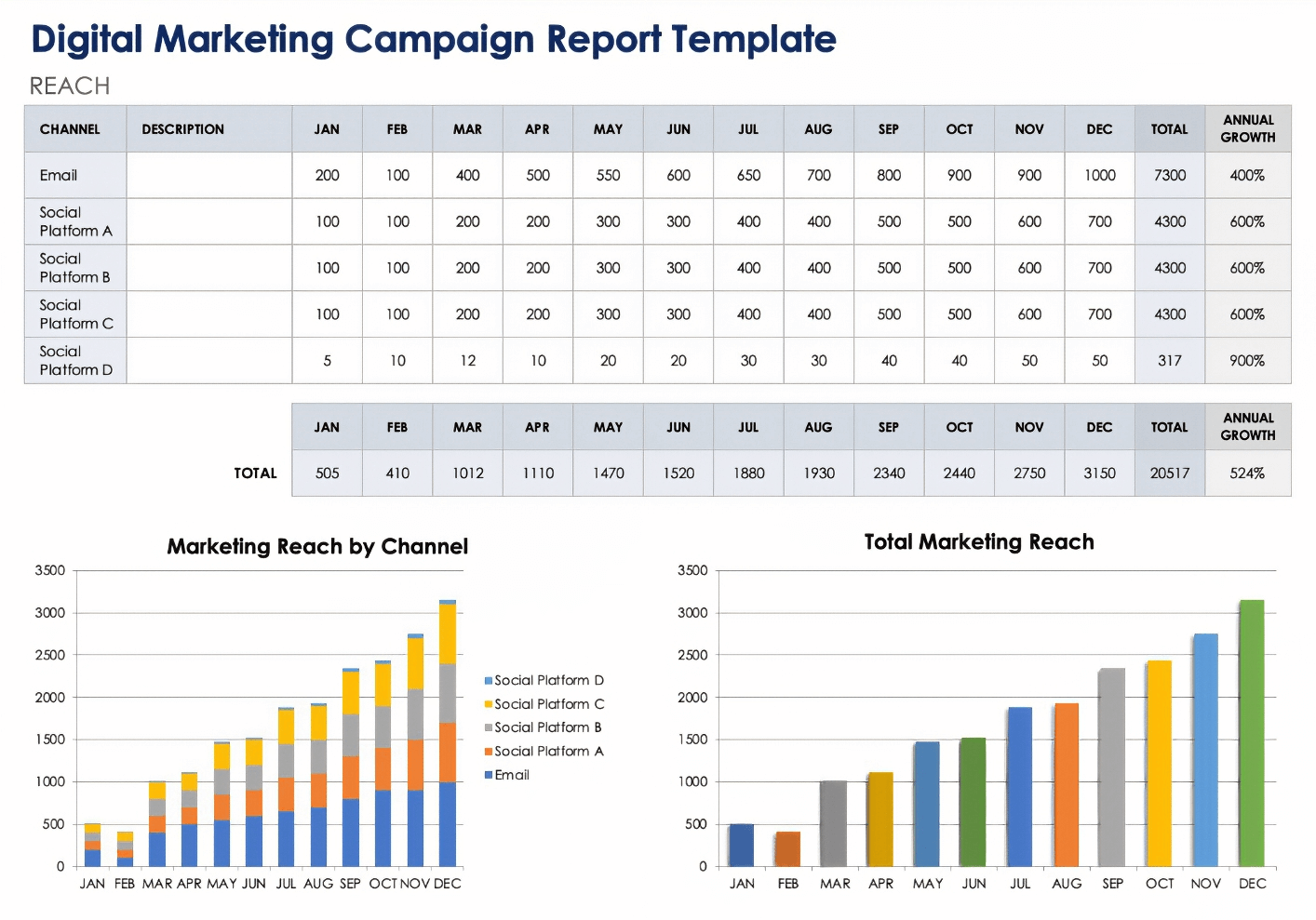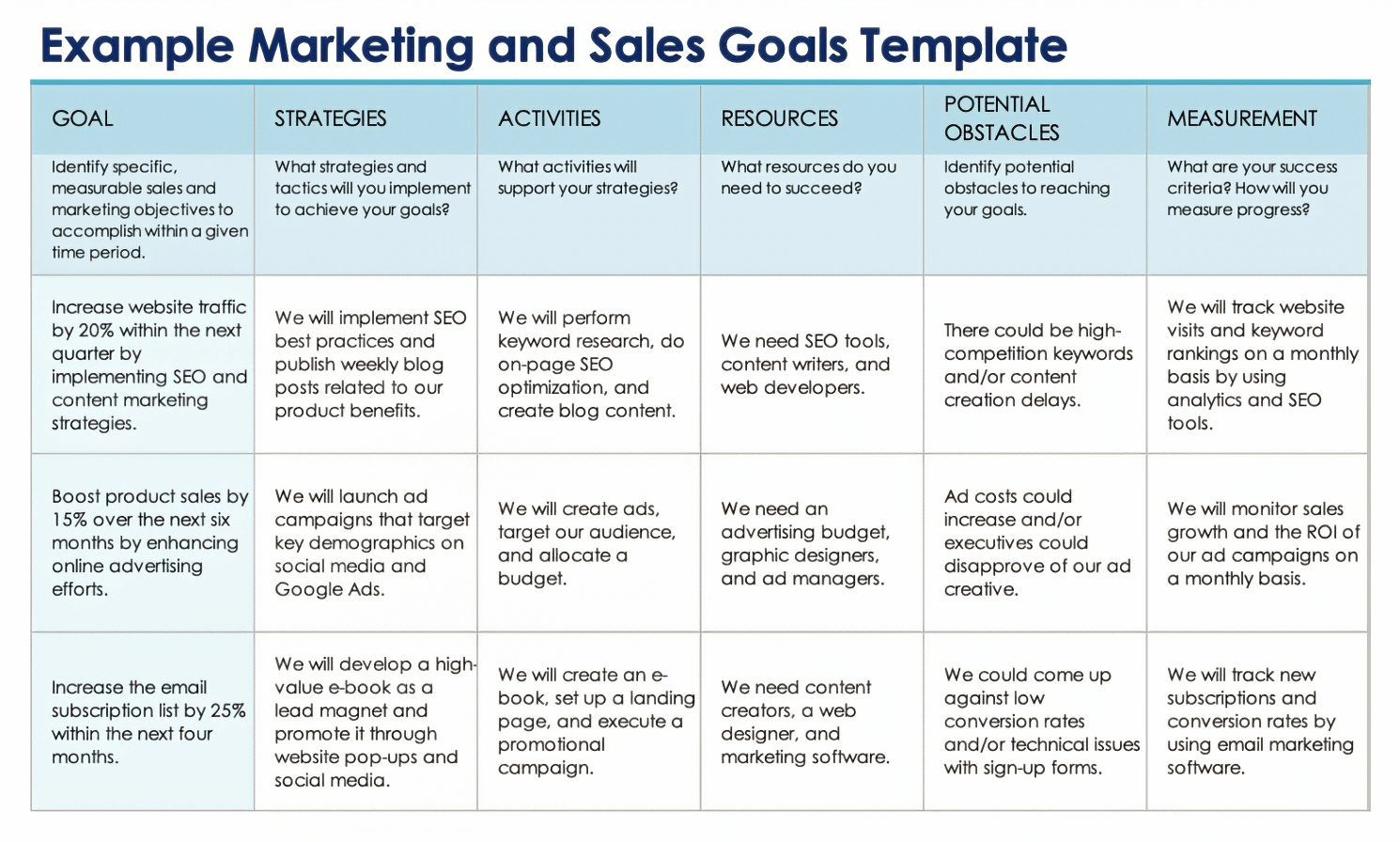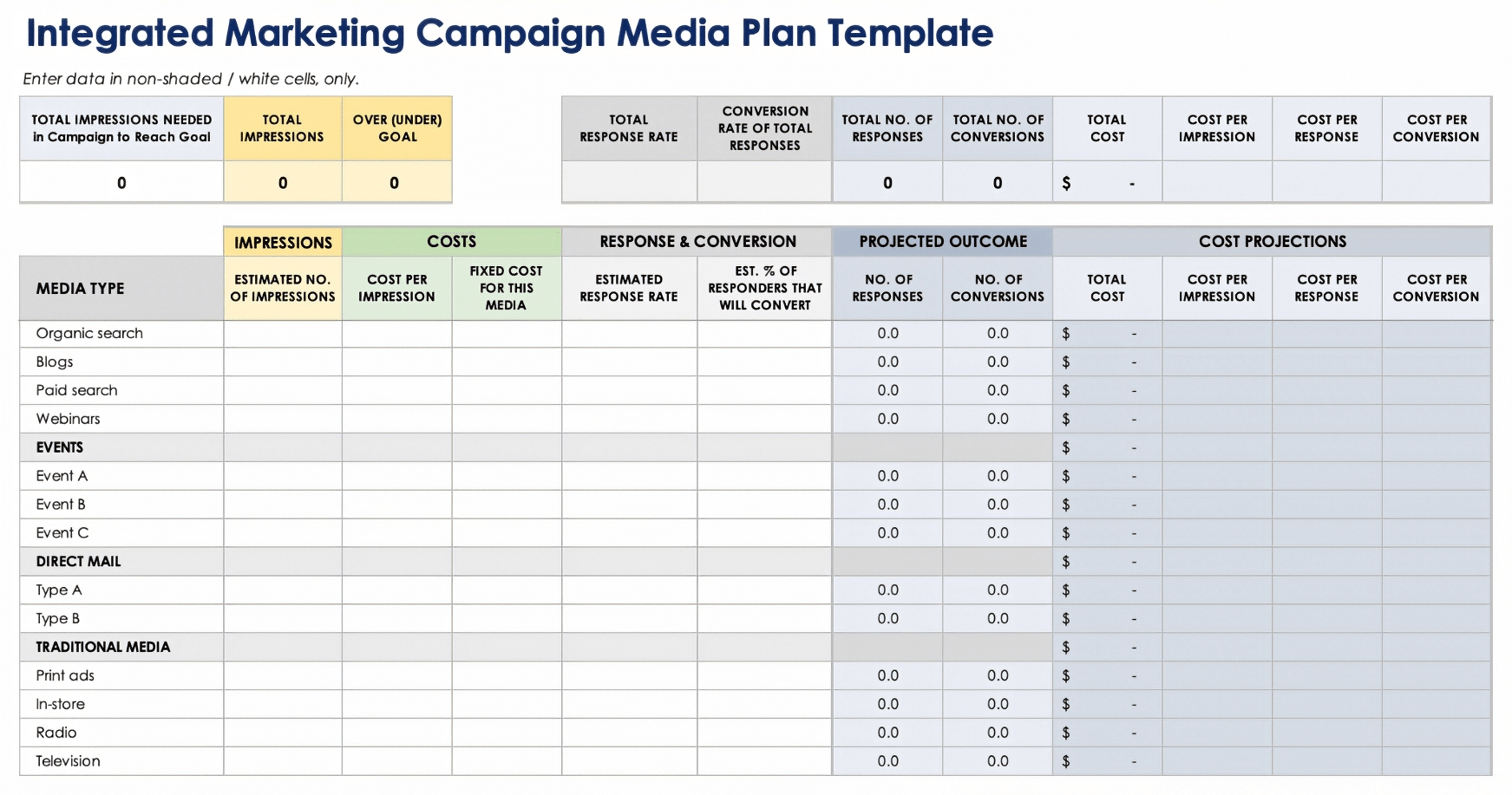What Are Marketing Objectives?
Marketing objectives are specific and measurable outcomes that a marketing plan aims to achieve within a set time frame. Examples include expanding market share by 20 percent in a year and increasing brand awareness in the 20-25 age demographic within six months.
Marketing Objective vs. Marketing Goals
Marketing goals are the broader aims that a business wishes to achieve. Marketing objectives are the specific outcomes within a goal that a business will need to execute in order to achieve the goal.
For example, if your broader marketing goal is to improve customer experience, a marketing objective would be to increase customer retention by 5 percent by the end of the year. Discover more examples of business goals.

View this chart to see the difference between goals and objectives.
Examples of Marketing Objectives
We have listed below different types of marketing goals with examples of specific, measurable, achievable, and time-bound (SMART) marketing objectives. Use these examples as benchmarks for your own marketing plan.
Digital Marketing Objective Examples
When it comes to digital marketing, it’s important to think about the entirety of your web presence and target different facets of how people interact with it. These objectives focus on tactics to improve digital marketing efforts.
- Hire a contract designer to make your website more efficient and user friendly in three months for improved customer experience.
- Increase social media impressions by 15 percent by the end of two quarters.
- Create a YouTube platform for your company, and produce a slate of at least three relevant videos by the end of the year.
- Boost customer conversion rate by 20 percent through targeted email campaigns in the next quarter.
- Expand email subscriber list by 25 percent by the end of this quarter.
- Increase organic search traffic by 30 percent by the end of the year.
Marcom Objective Examples
These examples represent the focus on branding and industry relationships when setting marketing communication objectives.
- Conduct market research for one month, and develop a strategy to communicate with that market by the end of the quarter.
- Set up relationships with five new industry influencers by the end of Q3, and sign promotional contracts with them.
- Build a positive brand image by placing at least five new instances of press coverage for the company or a product by the end of the year.
- Increase brand awareness by 15 percent with your target audience within 10 months.
- Use webinars to improve product awareness by 30 percent by the end of the quarter.
- Increase lead generation 20 percent with email campaigns in six months.
Marketing Plan Objective Examples
When creating marketing plan objectives, consider the larger goals you want to achieve and how to create objectives in concert with them.
- Increase revenue by 10 percent by the end of the fiscal year.
- Generate new leads by creating five new, branded content relationships by the end of Q2.
- Increase brand awareness and brand recall by 20 percent with a new brand campaign by the end of the quarter.
- Increase market share 10 percent by the end of the fiscal year.
- Launch a new product and achieve a 30 percent revenue increase by the end of the year.
- Increase market share by 15 percent by the end of the fiscal year.
New Business Marketing Objectives
New business marketing objectives should focus on collecting research to set the game plan for crafting brand identity.
- Conduct market research on your company’s target customers and competitors by the end of the quarter and use that data to craft a positioning statement.
- Build brand identity and brand reputation by allocating 15 percent more of the annual marketing budget to brand partnerships and influencer partnerships.
- Improve customer advocacy by increasing your customer service workforce by 10 percent by the end of the quarter and investing revenue into monthly customer service training sessions.
- Generate 200 leads through a targeted social media marketing campaign in the first six months after the launch of the business.
- Establish a brand presence on two major social media platforms and gain 5,000 followers total within the first six months.
- Attract 1,000 website visitors a month by the third month of the business launch.
New Product Marketing Objectives
For new product objectives, the aim should be expanding brand awareness to new markets while satisfying your current customer base.
Carmen Williams, Chief Evolution Officer and Fractional CMO at Evolve for Growth, suggests gaining more insight on customers through information gathered from live events and digital events, as well as getting in the conversation on forums. “It's all about building relationships. The more in touch you are with your customers, the more accurate your goals and objectives are going to be and the more likely you'll achieve them,” she shares.
- Reach new markets and obtain new customers by conducting marketing research on three new markets by the end of the quarter that you think would find the product meaningful.
- Expand brand awareness by increasing click-through rate on social media ads 5 percent within three months of completing marketing research.
- Increase sales revenue by 5 percent in the first three months after the product launch.
- Generate 500 leads pre-launch with email sign-ups and social media engagement six months prior to the product’s release.
- Secure partnerships with three key retailers to ensure product availability in at least 100 stores nationwide within the first six months.
Marketing Campaign Objective Examples
Marketing campaign objectives need to have a wider scope than regular marketing objectives.
- Increase conversions of people in the prospect pipeline to customers by 10 percent in the first three months after your marketing campaign.
- Create more brand awareness by targeting your campaign to three new markets or demographics by the end of the year.
- Increase reach and click-through rate by 15 percent on all forms of ads by the end of Q3.
- Increase sales revenue 30 percent by the end of the campaign.
- Grow subscriber base email list by 20 percent by two months after the campaign.
- Increase total social media followers by 15 percent by the end of the campaign.
Download a Marketing Campaign Report Template for
Microsoft Excel
| Google Sheets
Use this marketing campaign report template to track the performance of your social media platforms by campaign. Use that information to determine overall marketing reach and channel growth. Note: This template uses different data examples than the examples listed above.
Long-Term Marketing Objective Examples
Long-term marketing objectives should focus on big vision scope such as sales, return on investment (ROI), and staffing planning.
- Improve ROI by 10 percent upselling and focusing on high-value customers by the end of the year.
- Increase ad revenue by 20 percent by Q4.
- Hire a marketing manager in Q1 to set business and marketing goals for the current fiscal year.
- Improve search engine ranking to be in the top three search results for relevant keywords within the next six months by utilizing SEO strategies and deploying website optimization.
- Expand market share 15 percent in the next three years by capturing new markets and demographics with product and distribution channel diversification.
- Improve customer retention rate by 25 percent within the next 18 months by bolstering post-purchase support.
Download a Blank Marketing and Sales Goals Template for
Excel
|
Microsoft Word
|
Adobe PDF
This template can help you ideate long-term goals and consider potential strategies, resources, and obstacles. Once complete, use that information to think about how to measure the success of the goal.
Short-Term Marketing Objective Examples
Short-term marketing objectives detail smaller steps that are designed to further larger goals.
- Increase lead generation by 30 percent by offering a downloadable service for free by the end of Q2.
- Promote a 20 percent discount on a product to attract and potentially retain new customers this quarter.
- Develop a loyalty program to increase customer retention by 15 percent in six months.
- Improve brand awareness by securing coverage in at least two industry-relevant online publications in the next three months via PR outreach.
- Engage with followers regularly and create more interactive content to increase social media engagement by 15 percent by the end of the quarter.
- Increase web traffic by 20 percent by the end of Q2 by implementing SEO informed content marketing strategy.
Digital Channel Objectives
Digital channel objectives entail improving the entirety of your digital footprint.
- Double the click rate from Google Ads by targeting better keywords by the end of the year.
- Increase SEO capture by 25 percent in two quarters by improving keyword targeting.
- Gain 30 percent more social media followers by the end of the fiscal year with targeted advertising campaigns and influencer partnerships.
- Increase email database by 10 percent this quarter by optimizing the email sign-up process.
- Improve social media advertising ROI by reducing cost per acquisition by 15 percent over the next two quarters through audience targeting refinement and performance analysis.
- Increase the click-through rate of email campaigns by 20 percent within the next 3 months through A/B testing subject lines.
Download the Integrated Digital Marketing Campaign Media Plan Template for Excel
This template is a useful tool for managing all the moving elements of a digital marketing campaign. When you enter data such as total impressions, the sheet will auto-populate rows, making it easy to track your campaign’s effectiveness.
For other marketing tools to help you manage your efforts and meet company goals, check out this collection of digital marketing campaign templates.
SMART Marketing Goals Template
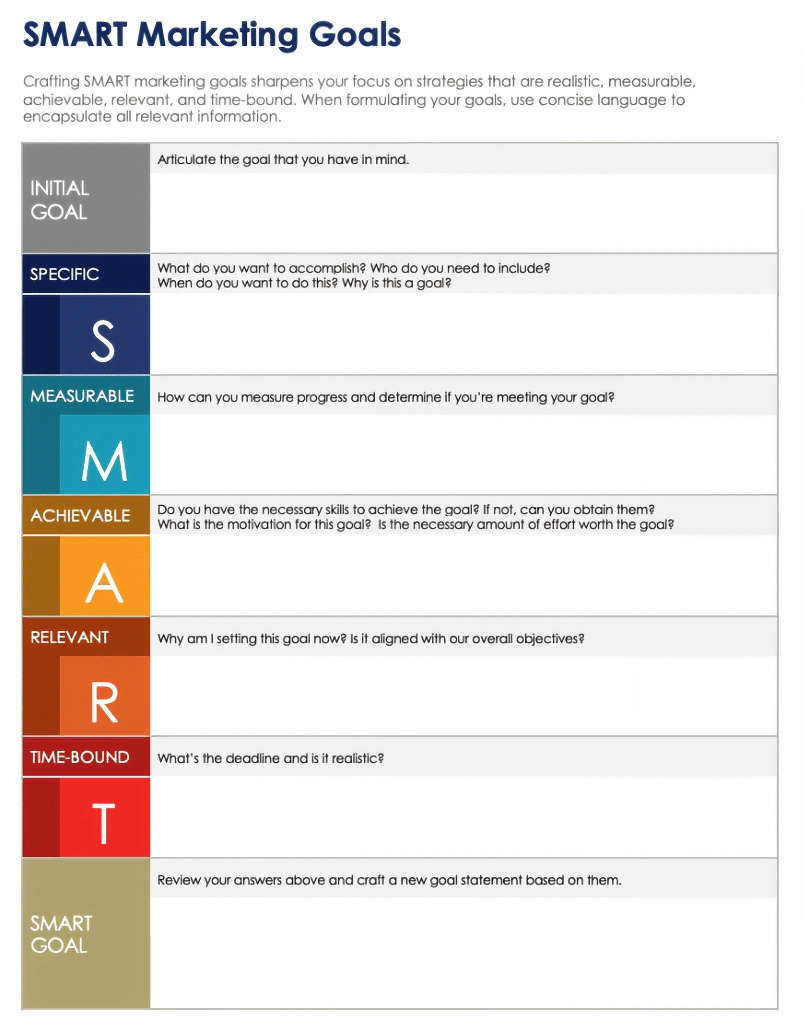
Download a SMART Marketing Goals Template for
Excel
|
Microsoft Word
|
Adobe PDF
Use this template to write SMART marketing goals. Once those are set, you can start to identify objectives to reach those marketing goals.
SMART Objectives Worksheet
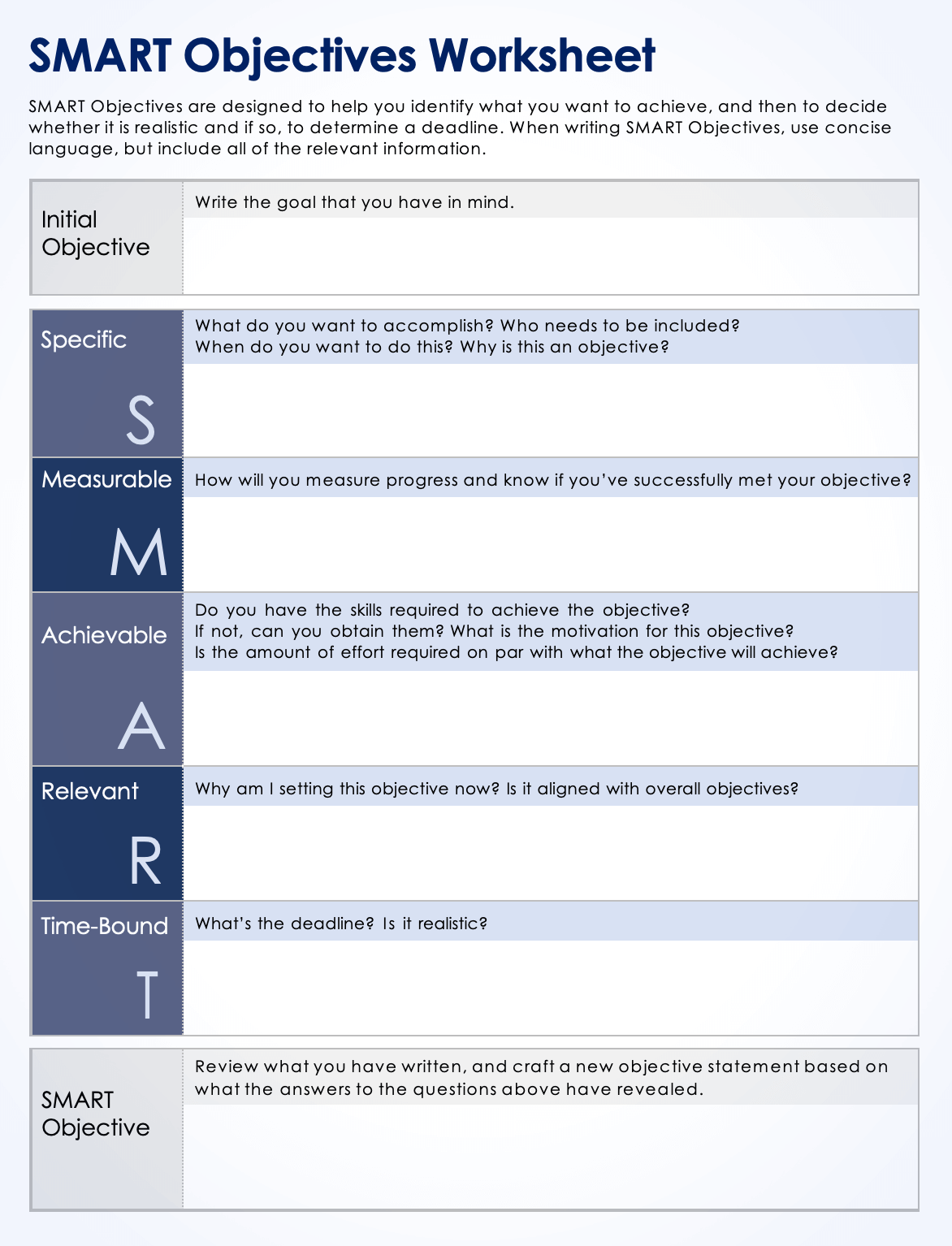
Download a SMART Objectives Worksheet for
Microsoft Word
|
Adobe PDF
This worksheet helps map out your marketing objectives and make sure they are specific, measurable, achievable, relevant, and time-bound. Separating out these components will keep your objectives useful and effective.
How to Set Marketing Objectives
Setting marketing objectives starts with taking stock of current objectives and the methods you’re using to achieve them. Once you analyze the efficacy of your current or past objectives, you will be able to start crafting, implementing, and measuring new ones.
“Marketing objectives need to be reasonable and attainable but also push you,” advises Williams, author of Evolve for Growth: Leading Innovation with an Evolutionary Approach.
- Review Goals and Objectives
Start by taking stock of past marketing objectives and how effective they have been. Use these goal tracking templates and OKR templates to keep everything running smoothly.
Joelle Palmer, Integrated Campaigns Director at CoreView, suggests: “Review last quarter's objectives and goals and assess how well you met them. Then use that to create and decide the objectives for the next quarter.” Palmer accomplishes this by running reports on programs from the past quarter and looks at what performed and what didn’t.” - Analyze Data Metrics
Spend time ascertaining what has and has not worked so far with your marketing efforts. Compare marketing metrics from the last quarter (such as email campaigns) and how it moved the needle on company metrics (such as sales). If one webinar had more downloads and led to more sales or email sign-ups, you know to put more resources into reproducing that as opposed to an email campaign with low click-through rate. - Ideate Goal Metrics for Objectives Based on Review of Past Efforts
Think about what are realistic objectives and goals based on the data you have collected. “You need to know how marketing metrics contribute to the company metrics,” explains Palmer.
Using measurable metrics, develop objectives that are in line with your marketing goals and are informed by your review of what has and hasn’t worked last quarter. - Make and Implement a Marketing Plan
After collecting the necessary data, you can build your new plan of forward motion. Make a plan for how you will execute and achieve your marketing objectives, based on what you know to be useful from your last quarterly review. If you haven’t done one before, follow this tutorial on how to write a marketing plan. - Measure Results
Keep track of the data and metrics you will need to be able to assess whether your marketing objectives hit their target by the specified time.
Download Marketing Goals Cheat Sheet
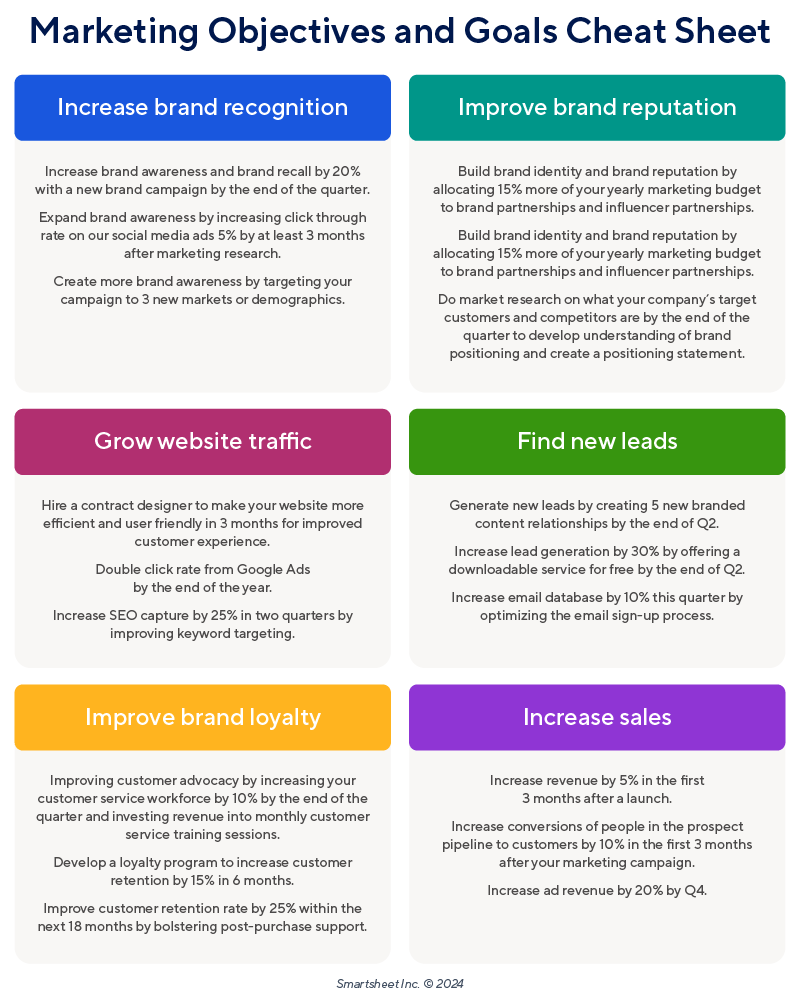
Download the Marketing Goals Cheat Sheet for Adobe PDF
This cheat sheet shows popular marketing goals alongside a list of specific, measurable, achievable, relevant, and timely marketing objectives. Use this document as inspiration for creating useful marketing objectives for your own marketing goals.
Using SMART Marketing Objectives
SMART objectives are specific, measurable, achievable, relevant, and timebound to your marketing goals. Once you have a marketing goal in mind, set the objective by picking a specific action outcome that you want to measure that will set you up to achieve your goal.
Make sure the action outcome is measurable by metrics that you can review. Then assess whether the objective is achievable with the teams available to work on it. Think about if this objective will be relevant to achieving a specific larger goal. Set a reasonable time limit that you will aim to achieve the outcome that you have set.
Learn how to write SMART goals and turn them into objectives.
Track Your Marketing Objectives and Goals in Smartsheet
The best marketing teams know the importance of effective campaign management, consistent creative operations, and powerful event logistics -- and Smartsheet helps you deliver on all three so you can be more effective and achieve more. The Smartsheet platform makes it easy to plan, capture, manage, and report on work from anywhere, helping your team be more effective and get more done. Report on key metrics and get real-time visibility into work as it happens with roll-up reports, dashboards, and automated workflows built to keep your team connected and informed. When teams have clarity into the work getting done, there’s no telling how much more they can accomplish in the same amount of time. Try Smartsheet for free, today.

